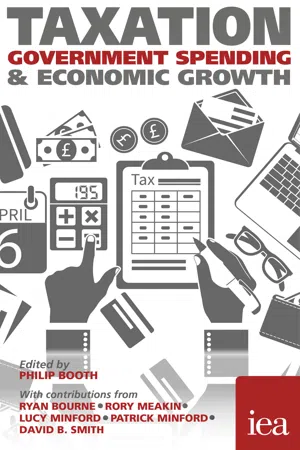IntroductionPhilip Booth
The growth of government spending
The measurement of national income and government spending is perhaps surprisingly controversial. An indication of the difficulties was given in the wake of the government’s 2014 Budget when one BBC commentator suggested that planned reductions in government spending as a proportion of national income would take us back to the days of The Road to Wigan Pier (that is, to the 1930s). More careful analysis of definitions of national income and the different categories of government spending demonstrated that this assertion was a long way wide of the mark – indeed, it was absurd.
Analysis of the data shows that since the beginning of the twentieth century there has been a huge growth in government spending. This growth has varied somewhat across countries, but the pattern has been remarkably consistent.
So, what can we say about government spending over time? Table 1 shows government spending as a proportion of national income for six countries since 1870 and is a summary of Table 7 in Part 1. In the UK, government spending has grown from around 10 per cent of national income at the beginning of the twentieth century to somewhat over 40 per cent today. There were big jumps in spending during the two world wars.
The trends in the other countries are similar. It is notable that in the US, often regarded as different from other countries, government spending is nearly 40 per cent of national income, higher than in Australia. The ‘continental’ model is often regarded as being distinct from what is often described as the ‘Anglo-Saxon neo-liberal’ model, and yet, interestingly, government spending in Germany as a proportion of national income is more or less identical to that in the UK. There certainly are some continental outliers, with the governments of Italy, Sweden, Austria, Belgium and France (the latter shown in this table) all spending over 50 per cent of national income. However, the UK is, in fact, above the OECD average.
Indeed, the figures in Table 1, it can be argued, understate the rise in government spending that has taken place. In the table, national income is measured at market prices. Some regard this as inappropriate given that the market price measure of GDP includes taxes that are levied on goods and services that are sold rather than the underlying costs of those goods and services. If we measure government spending as a proportion of national income measured at what is known as ‘factor cost’, the current level of government spending is just over 45 per cent of national income. Indeed, using the factor-cost measure of national income, government spending in the UK overtook private spending in the late 2000s, before falling back to its current level of a little less than half of national income.
Table 1 Ratios of general government expenditure, including transfers, to money GDP at market prices (%) – selected countries
|
Australia | 18.3 | 16.5 | 19.3 | 14.8 | 21.2 | 34.1 | 34.6 | 36.6 | 35.6 |
France | 12.6 | 17.0 | 27.6 | 29.0 | 34.6 | 46.1 | 51.1 | 56.4 | 57.0 |
Germany | 10.0 | 14.8 | 25.0 | 34.1 | 32.4 | 47.9 | 44.7 | 47.4 | 44.0 |
UK | 09.4 | 12.7 | 26.2 | 30.0 | 32.2 | 44.7 | 37.8 | 48.8 | 43.2 |
USA | 07.3 | 07.5 | 12.1 | 19.4 | 30.0 | 35.3 | 33.9 | 43.2 | 37.8 |
Sources: Tanzi and Schuknecht (2000),OECD Economic Outlook (June 2016, Annex Table 29), and OECD data bank.
Government spending, taxation and growth
One of the major objectives of this book is to examine the impact of taxation on growth. However, the focus in much of the data and analysis is on government spending rather than taxation. The reason is that, ultimately, it is government spending that determines the total tax burden. Especially in recent years, government spending has been considerably higher than taxation with the difference being made up by government borrowing. However, government borrowing requires financing and consumes real resources that could have an alternative use. Furthermore, government borrowing leads to a future tax burden. There are potential qualifications to this argument, such as the fact that the debt burden falls (all other things being equal) as nominal national income grows. However, as a rule of thumb, it is assumed in much of this book that it is the financing of government spending that ultimately imposes a burden on the private sector rather than taxation as such. The focus is therefore very much on government spending as the main long-run determinant of the tax burden.
Can government spending be growth enhancing?
Not all government spending harms economic growth. For example, notwithstanding the literature on private governance (see, for example, Stringham 2015), it can be argued that effective judicial and policing systems are necessary for a thriving business economy. Furthermore, it is possible that investment in certain forms of economic activity (such as pure research) has public good qualities and will be under-provided in an entirely free market. Infrastruc...
